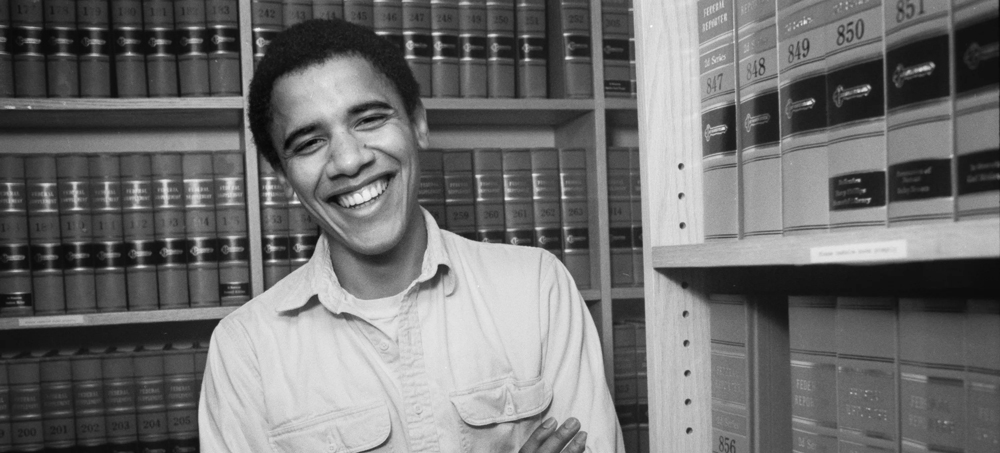The Democrat’s White People Problem
Marc Ash Reader Supported News 1991: Then head of the Harvard Law Review and future President Barack Obama. (photo: Obama Library)
1991: Then head of the Harvard Law Review and future President Barack Obama. (photo: Obama Library) The Democrat’s White People Problem
Marc Ash Reader Supported NewsI am a Northern California Democrat. My vote for Kamala Harris in the recent presidential election was by no means the first. I had voted for her for attorney general of California (twice), for US Senator, and Vice President prior. I had total confidence in her and I would much prefer that she were President today. However I am aware that some voters, particularly white voters in more conservative states have reservations.
White voters remain by far the largest ethnic voting block in the United States, comprising roughly 65 to 70 of the electorate. The republican candidates dominate the White vote and they do it by playing the race card. If the Democrats want to be competitive nationally they have to be better at wooing white voters. It’s just simple math.
It is important to note that the last Democratic presidential candidate that won all so called battleground states, Ohio and North Carolina was Barack Obama. So just choosing white candidates is not a guarantee of success at the polls. To be successful a presidential candidate also has to be a uniquely gifted communicator, have an unusual degree of charisma and possess one additional quality, perhaps the most important and difficult to define, dynamism.
A dynamic candidate presents a dynamic vision and that vision almost always includes above all else, change. Bill Clinton represented change from 12 years Reagan-Bush I policies. Barack Obama represented change from 8 years of Bush II policies. In 2016 two candidates emerged that represented dynamic change. Donald Trump and Bernie Sanders.
Both Trump and Sanders were outsider candidates talking about significant change, vastly different forms of change but change nonetheless. Dynamism in a political sense is also defined by a stark vision, a defining vision, a rationale for action. “I want to be President,” is not enough. What is needed are candidacies built around an agenda, “I’m going to fix this problem.” “I’m going to create this program.” “This is my cause, my reason for running, and your reason for supporting me.”
But there is a catch, while voters like dynamic candidates party establishment figures tend not to. Dynamic candidates challenge the status quo and often party establishment figures feel threatened by that.
The heyday of civil rights legislation was the 1960’s. It was the moment after the assassination of John F. Kennedy that the vision of great civil rights leaders like Medgar Evers, Dr. Martin Luther King Jr. and John Lewis were transformed into transformative laws. Those Civil Rights era laws would forever change American society. It was also the waning of the white-male Capitol Hill era.
In the 1960s congress was still dominated by white men, as it had been since the very first congress in 1789. There were literally members of Congress who openly campaigned on and espoused segregation. But there were also white male moderates, those were the members who were key to passing the Civil Rights Act of 1964 and the Voting Rights Act of 1965. And it was also in that climate that the landmark Supreme Court Roe v Wade ruling emerged.
The Democratic party has clearly embraced diversity and inclusion. It’s a decision that makes sense on a lot of levels. Diversity and inclusion are good for society on a social just level ,but also on an economic level. A well educated, diverse workforce makes workplaces stronger and more productive. Diversity and inclusion have paid for themselves many times over.
The problem for the Democrats is that when the Republicans play to white fears on race, particularly at election time the Democrats struggle to address the primal fear factor. Primal, tribal fears are embedded deep in the subconscious mind. It’s takes gifted communicators like Clinton and Obama to overcome the racist dog whistles.
The key to Democratic success is an open nominating process. After Joe Biden reluctantly stepped aside in the run-up to the 2024 presidential election the Democratic party hastily anointed Kamala Harris the party’s candidate. It may have been the only thing they could do, but it was also the worst thing. When the party choses the candidate the voters become disengaged. The winning candidate is the candidate the voters say it is.
